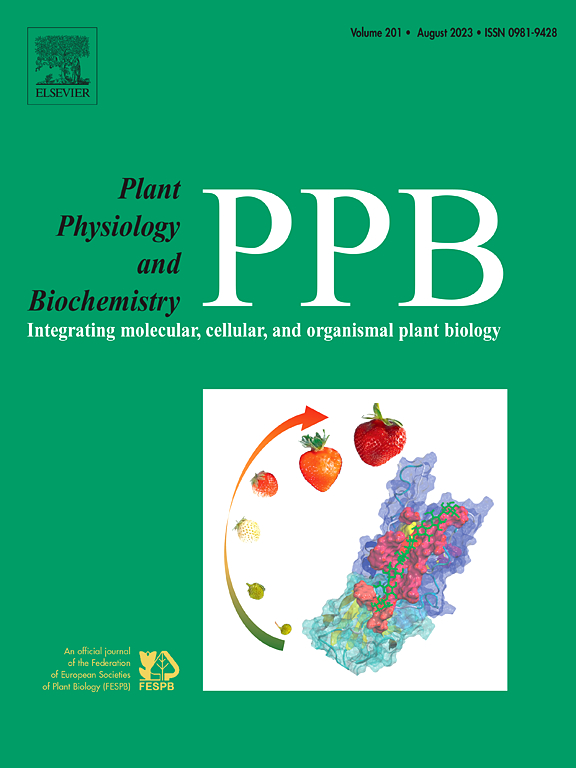香草荚(vanilla planifolia, Andrews)在腌制过程中生化、超微结构的变化。
IF 6.1
2区 生物学
Q1 PLANT SCIENCES
引用次数: 0
摘要
香草被用于几个行业,因为在手工腌制过程中,合成了高要求的香气的化合物。这个过程涉及物理、生物化学、微生物学和结构变化,通过高分辨率技术的研究,可以在超结构水平上进行深入的内省,以识别细胞结构。在这个过程中,在导致豆荚的条件下,允许合成,释放和储存分子香气。上述变化的整合将允许制定策略,从而更好地利用香草提取物及其在提取过程后获得的残留物(约95%),而鞘可能会受到这些残留物的影响。近端化学分析显示,在10 SS(干-汗循环)时,与油树脂和香气相关的化合物的脂质增加(~ 25%)。蛋白质增加(约50%),这是与内生菌群相关的酶的催化活性的结果。β-葡萄糖苷酶与芳香族化合物的合成有关,在10 SS (196 IU/mL)下,其活性增加。通过扫描电镜和图像分析,中果皮显示折叠和收缩(~ 50%)。利用CLSM测定了大豆中主要化合物的位置,并分析了它们与超微结构的关系。利用透射电镜,鉴定了负责气味化合物积累的质体红蛋白和负责其运输和储存的胞间连丝。对固化过程和相关现象的综合研究,使过程关键阶段的识别成为可能,这对于提出最佳利用代谢物及其残留物的策略至关重要。本文章由计算机程序翻译,如有差异,请以英文原文为准。

Biochemical, micro and ultrastructural changes in vanilla pods (Vanilla planifolia, Andrews) during the curing process
Vanilla is used in several industries, due to during the artisanal curing process, compounds responsible for a highly demanded aroma are synthesized. This process involves physical, biochemical, microbiological and structural changes, which through their study with high-resolution techniques allowed for deep introspection at the ultra-structural level, to identify cellular structures. Which, under conditions leading to the pod during the process, allow the synthesis, release, and storage of molecules aroma responsible. The integration of the referred changes will allow the strategies generation that lead to better use of the vanilla extract and its residue obtained after the extraction processes (∼95%) to which the sheath could be subjected. The proximal chemical analysis showed an increase in lipids (∼25%) at 10 SS (drying-sweating cycles) associated with oleoresins and aroma responsible compounds. Proteins increased (∼50%), a result of the catalytic activity of the enzymes present and associated with the endophytic flora. β-glucosidase associated with the synthesis of aromatic compounds, increased their activity at 10 SS (196 IU/mL). The mesocarp showed a folding and shrinkage of (∼50%), evaluated by SEM and image analysis. Using CLSM, the major compounds in the bean were located and their relationship with the micro and ultra-structure. Using TEM, plastoglobules responsible for the odorant compounds accumulation and plasmodesmata for their transport and storage were identified. The comprehensive study of the curing process and the phenomena conjunction involved, allowed the process key stage identification, important for the proposal of strategies that lead to the optimal use of the metabolites and their residues.
求助全文
通过发布文献求助,成功后即可免费获取论文全文。
去求助
来源期刊
CiteScore
11.10
自引率
3.10%
发文量
410
审稿时长
33 days
期刊介绍:
Plant Physiology and Biochemistry publishes original theoretical, experimental and technical contributions in the various fields of plant physiology (biochemistry, physiology, structure, genetics, plant-microbe interactions, etc.) at diverse levels of integration (molecular, subcellular, cellular, organ, whole plant, environmental). Opinions expressed in the journal are the sole responsibility of the authors and publication does not imply the editors'' agreement.
Manuscripts describing molecular-genetic and/or gene expression data that are not integrated with biochemical analysis and/or actual measurements of plant physiological processes are not suitable for PPB. Also "Omics" studies (transcriptomics, proteomics, metabolomics, etc.) reporting descriptive analysis without an element of functional validation assays, will not be considered. Similarly, applied agronomic or phytochemical studies that generate no new, fundamental insights in plant physiological and/or biochemical processes are not suitable for publication in PPB.
Plant Physiology and Biochemistry publishes several types of articles: Reviews, Papers and Short Papers. Articles for Reviews are either invited by the editor or proposed by the authors for the editor''s prior agreement. Reviews should not exceed 40 typewritten pages and Short Papers no more than approximately 8 typewritten pages. The fundamental character of Plant Physiology and Biochemistry remains that of a journal for original results.

 求助内容:
求助内容: 应助结果提醒方式:
应助结果提醒方式:


